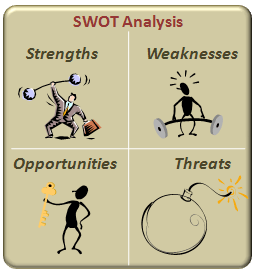Strategy is an integrated explanation of how an organization is going to guide its performance into the future.
In Part III of "What is Strategy?" we consider your current reality. Once you have identified the future to which you
are headed (e.g., Vision, Goals) then the obvious question is “How are we going
to get there?” But don’t start
brainstorming just yet. Before doing
this, you need to make sure that you have a clear and accurate
understanding of your current reality. Only
in this way will you be able to create a strategy that fully leverages your
resources.
SWOT analysis is the most traditional part of
strategic planning – and the part most often done poorly.
First, I recommend doing SWOT analysis AFTER an
organization has identified the future it wants to pursue. This is opposite of how SWOTs are usually
done. By doing SWOTs toward the end of
the process you allow yourself to follow your dreams and aspirations rather
than to be constrained by your environment.
See my blog about how SWOT is “Better Backwards” at this link.
When you do SWOT analysis at this stage, you are
asking yourselves “What are the most relevant Strengths, Weaknesses,
Opportunities, and Threats that we need to keep in mind as we pursue our Vision
and Strategic Goals?”
Next you have to actually identify the “correct”
SWOTs that are most important in getting you to your Vision and Goals. And that proves to be very challenging for
organizations.
Let’s start with the analysis of internal
Strengths & Weaknesses. So often
this is not done with much thought or very systematically. I recommend using an organization assessment
tool for this process, such as the VPP/McKinsey OCAT. It is also important that you have a culture
of actually telling the truth to one another about your Weaknesses. If you don’t have that, then you are going to
make strategy errors.
The same goes for an analysis of the external
Opportunities & Threats that the organization needs to be aware of. Organizations need to cast a wide net,
collect data, involve stakeholders, and find out what possible Opportunities
are out there and what Threats they need to be aware of.
Getting the SWOTs wrong – missing any of the SWOTs
– can totally thwart an organization’s strategy development process. If you do not understand the “hand you have
been dealt” then you cannot “play it” effectively. If you miss the Aces you are holding or,
worse, confuse Deuces for Aces, then you are in trouble. For example, if you think that you have a
Strength with a “Board that cares” and you need to raise lots more money, then
it may really be a Weakness if this Board does not have access to funds.
Get the SWOTs right and then we will move on to writing an integrated strategy narrative in the next installment.
For more
ideas on how you can lead breakthroughs in your organization, follow this blog
and check out my web site at www.SheehanNonprofitConsulting.com You will find free resources you can
download, including a Breakthrough Strategy Workbook that you can download at
no cost. You can also check out my book,
Mission Impact: Breakthrough
Strategies for Nonprofits, and buy it if
you are interested. And you can follow Sheehan
Nonprofit Consulting on Facebook.

No comments:
Post a Comment